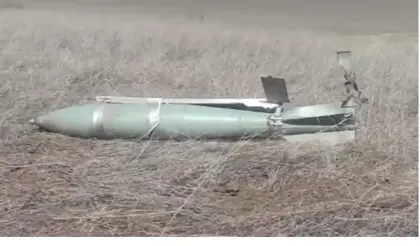Ukrainian border guards detonated a Russian cluster bomb in the Donetsk region, which had been intercepted without triggering an explosion, the State Border Service reported via Telegram.
JOIN US ON TELEGRAM
Follow our coverage of the war on the @Kyivpost_official.
The bomb was rendered safe by the anti-aircraft guards of the “Revenge” Offensive Guard Brigade.
The ZU-32-2 team caught the wings of the 250mm bomb cartridge, causing it to fall without detonating, the report detailed. The ZU-23-2 is a Soviet-era 23mm twin anti-aircraft gun designed to engage air targets up to 2.5 kilometers high and lightly armored targets up to 2 kilometers (1.2 miles) away.
“After inspection, the sappers safely detonated the bomb due to the continued danger it posed,” the report added.
Kyiv Post could not independently verify the video’s location and timing.
The RBK-250, a single bomb cassette, is a cluster bomb weighing 273 kilograms (602 pounds) with a 250mm caliber. It contains 150 AO-1 fragmentation munitions, with a total warhead weight of 150 kilograms (331 pounds). This bomb covers an area of 4,800 square meters and can be mounted on Su-17 fighter-bombers and Mi-24 helicopters.
These bombs were utilized during the Afghan and Chechen wars by fighter-bombers, assault aircraft, and helicopters. In a span of three weeks during Operation Volna in 1985, the Soviet Air Force dropped 416 of these cluster bombs.

Russian Missile Attack in Odesa City Center Leaves at Least 10 Dead, 47 Injured
Human Rights Watch reported that the Russian air force used this type of bomb in August 2008 during the bombing of Gori, Georgia. However, the General Staff of the Russian Armed Forces denies the use of cluster munitions in this war.
You can also highlight the text and press Ctrl + Enter






